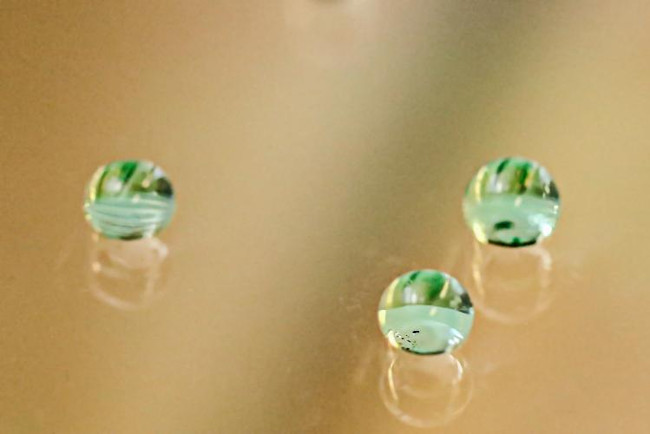New research shows the motion of water molecules
A new approach to studying water viscosity has revealed new insights into the behavior of water molecules and can open the way for liquid electronics to be manufactured and applied in the future. hybrid
A group of researchers led by Oak Ridge National Laboratory in the Department of Energy uses a high-resolution X-ray scattering technique to measure close bonding involving a hydrogen atom sandwiched between two integers. oxygen. This hydrogen bond is a quantum mechanical phenomenon responsible for the different properties of water, including viscosity, determining its ability to resist water or its ability to change its shape.

While water is the most abundant substance on earth, its behavior at the molecular level is not well understood.
Research by a scientific group published in Science Advances has demonstrated that they can explore the dynamics of water and other liquids in real time. Previous studies have provided photographs of the atomic structure of water, but few know how water molecules move.
To get a clearer picture, the ORNL-UT team used an advanced X-ray technique called inelastic X-ray scattering to determine molecular motion. They found that the dynamics of oxygen-oxygen-to-oxygen interactions between the water molecules were completely random but also highly coordinated. When the water molecules link is interrupted, strong hydrogen bonds will maintain a stable environment for a certain period of time.
"We find that the time required for a molecule to change its" neighbor "molecule will determine the viscosity of the water," Egami said. This new discovery will stimulate further research on controlling the viscosity of other liquids.
Egami sees his current work as a springboard for further research, which will promote neutron scattering techniques to further determine the origin of viscosity and other kinetic properties of liquids.
The researchers' approaches can also be used to describe molecular behavior and viscosity of ionic, or salt water, and other liquids, helping to develop semiconductor devices. New with liquid insulation layer, better battery.
See more:
- Three-dimensional molecular biology technique, the foundation for "hibernation" technology of the future to win the Nobel Prize in Chemistry
- Why hot water freezes faster than cold water
- Concussion conclusions: In addition to 3 solid, liquid, water gas, there is a fourth state
You should read it
- Should GPUs be liquid-cooled for better performance?
- The interesting scientific knowledge that we missed while at school
- How to Fill Tractor Tires with Water
- Concussion conclusions: In addition to 3 solid, liquid, water gas, there is a fourth state
- How to remove and repair iPhone contaminated with water and liquid
- Successfully formulated, programmable, liquid metal fabrication that can conduct electricity
- Uranus's 4 icy moons can exist liquid water oceans
- Liquid heat sink
May be interested
- 3D printed bus shelters were put into service first in the world
 winsun construction has revealed the world's first 3d printed bus stop.
winsun construction has revealed the world's first 3d printed bus stop. - Humanoid robots can exercise and even sweat when hot
 a group of japanese robot robots have built a human model that mimics the physical complexity of a human being.
a group of japanese robot robots have built a human model that mimics the physical complexity of a human being. - The next robot can cure satellites, destroying the space fleet
 nasa has partnered with us defense research agencies to build robots not only to refuel and repair satellites but also to counter enemy spacecraft in the event of a space war.
nasa has partnered with us defense research agencies to build robots not only to refuel and repair satellites but also to counter enemy spacecraft in the event of a space war. - Sea stars inspire new generations of robots that can adapt to physical injuries
 researchers at tohoku university and hokkaido university have succeeded in developing a robot capable of instantly adapting to unexpected physical damage for the first time.
researchers at tohoku university and hokkaido university have succeeded in developing a robot capable of instantly adapting to unexpected physical damage for the first time. - The world's first solar tram officially launched
 people living on the northern coast of new south wales in australia will have the opportunity to experience new, more sustainable transportation services. it is a new transport facility described by byron bay railway company as the world's first solar ship.
people living on the northern coast of new south wales in australia will have the opportunity to experience new, more sustainable transportation services. it is a new transport facility described by byron bay railway company as the world's first solar ship. - Helite safety belts help protect your hips
 helite has many years of experience in developing a dedicated airbag system for various activities, from horse riding to skiing. now, this french company has just released a specialized airbag for the elderly. it's called the hip'air belt.
helite has many years of experience in developing a dedicated airbag system for various activities, from horse riding to skiing. now, this french company has just released a specialized airbag for the elderly. it's called the hip'air belt.






 Macromedia Flash - Water bubble effect
Macromedia Flash - Water bubble effect Learn About Motion: The AI-Powered Task Manager
Learn About Motion: The AI-Powered Task Manager Decode the mystery of the Mpemba effect
Decode the mystery of the Mpemba effect The future of computing lies in organic molecules?
The future of computing lies in organic molecules? How to make Stop Motion videos on Android phones
How to make Stop Motion videos on Android phones